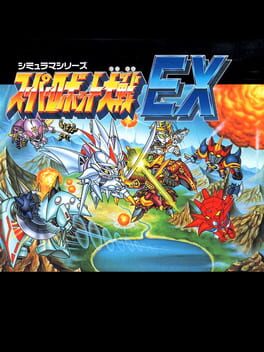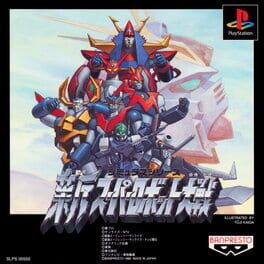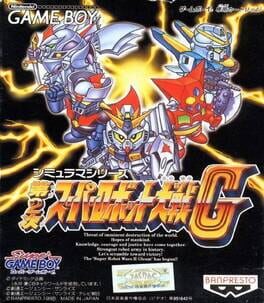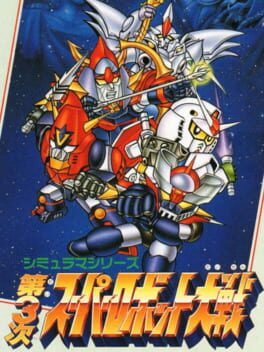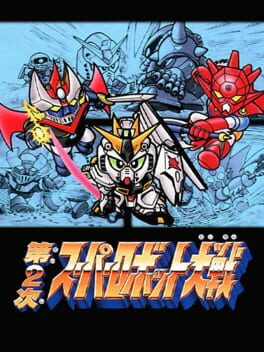

Only released in Japan.
Also in series
Reviews View More
A few weeks back, I dragged myself through the first of the three scenarios in this and thoroughly didn’t really care for it. I didn’t care for it to such an extent that I totally wrote off playing through the other two, and kinda got fed up with SRW in general. But after writing a pretty biting review and then sorta drifting around among not playing anything at all for a week, I decided to give the other two scenarios a chance. I’m really thankful I did, because I ended up enjoying them much much more than that first one. I’m not sure I’ve ever outright written a replacement review on purpose, but this is one case where it’s absolutely deserved. EX still certainly isn’t my favorite SRW game. It isn’t even my favorite of the three games in the Complete Box remake pack. But it’s definitely a game I can recommend much more easily than I could before. It took me around 60 or 70 hours to get through all three scenarios on original hardware.
Taking a bit of an unconventional approach from just about any other SRW game (at least that I’m aware of), EX has not just one story with diverging paths, but three different scenarios with very slight paths within them (with one exception being a sorta route 3.5 tucked in the middle of the second scenario, which I did not play). A month or so after the events of SRW 3, several of our heroes find themselves sucked into the world inside the Earth of La Gias, a world of high technology and magic. Each of the three scenarios follows one of three main characters going through different events in the conflict concurrently to one another that increase in difficulty as they go along. The first is the most dull and the easiest and more or less sets up the world and its conflicts and principle players, the second is the other main side of that conflict but still good guys, and the third is playing as a more grey hero on a third, tertiary side of the conflict.
I was originally very harsh on the writing in this game having only played through the first scenario. It focuses very hard on the original characters in an overly boated plot that sidelines the more interesting characters HARD, and makes the debut licensed series in this game, Aura Battler Dunbine and Go Shogun, feel like very distant tertiary concerns (because quite frankly they are), and while it isn’t a huge deal, the new series introduced in SRW 3 being all absent here (no Raideen, Combattler V, or Daitarn 3) was also a bummer. The second and third scenarios are written much better, with far better pacing and usage of licensed characters, and while they do still focus on the original characters more than I’d like, they’re far better conceived narratives than the first scenario. It’s only a shame that you need to play through the first two scenarios to unlock the third one, as slogging through scenario 1’s Fire Emblem wannabe plot is nowhere near as fun as the content it’s gating.
There’s also a neat system where you can use the completed save data from previous scenario playthroughs to alter your playthroughs of successive scenarios (and playing through the second scenario again after playing through the third is how you get that 3.5 route I didn’t do), which is a neat system but ultimately not all that thoroughly used or interesting in its execution. The writing is very uneven, with relatively high peaks but very low valleys, and while scenarios 2 and 3 are much more like the other Winky Soft-era SRW games in their quality, the very boring and poorly paced first scenario gives EX the odd man out of having easily some of my favorite and least favorite writing in the Complete Box games (with Scenario 3 being my personal favorite of the bunch).
Mechanically and design-wise, we’re still very much similar to the other remakes found in the Complete Box. Counter attacks are a thing, equippable items are a thing, pilots and mechs being separate is a thing, and pilot passive skills are a thing (which itself is something I only recently realized was an innovation of SRW 4, meaning none of the first batch of SRW games on SNES had passives :O). The thing most worth mentioning in the mechanics is the level design. Where SRW 2 was one shorter campaign with very few units, and SRW 3 had a fair few more units along a significantly longer campaign, EX is three campaigns that all play like they have the unit count of SRW 2 but the capacity for level design of SRW 3. What comes out of that is generally some very well put together campaigns, but we’ve gotten a bit further into the bad habits that started popping up in SRW 3.
While I definitely dig the more puzzle-like approach of fielding basically all of your units in every map (something much more present in the second and third scenarios than in the first), what I really don’t enjoy are how SO many maps have so many huge damage sponge bosses to contend with (especially in the first scenario). It isn’t even particularly a challenge, as there (thankfully) isn’t even a total turn counter you’re playing against for a best ending (like SRW 3 and 4 have). They’re just there to drag things out, and in a game with unskippable battle scenes, I really didn’t appreciate that. The other elephant in the room is occasional HUGE jump in difficulty that will just ambush you out of nowhere. Just about each one of the scenarios has at least one really brutal mission (with the worst being in scenario 2, for me), and that’s not counting the awful mission each of them has where you’re just fighting three to five super huge boss-type enemies. The unavailability of little enemies to grind up willpower with means that a meaningful portion of your army (especially the Aura Battler Dunbine guys) are basically useless because their only worthwhile moves are willpower gated, and they just about always devolve into a frustrating slog of how to use your resources in such a way that you can still take them out. While that sounds fun in concept (it even sounded fun typing it out here despite having already gone through it), they’re so taxing and often leave so little room for error that they end up being far less fun than the other puzzle-like missions of the game.
The presentation of the game is very much par for the course for the other Complete Box games. Pretty decent music for Winky Soft’s PS1 games, and nice enough animations and sprites. The big new addition worth talking about are all of the isekai-type magic-y mechas in the world of La Gias. They’re on the whole alright. I’m not a huge fan of most of SRW’s original designs, particularly during the Winky Soft era, but they’re still nicely made even if they’re by and large far too over-designed for their own good.
Verdict: Hesitantly Recommended. The quality of the later two scenarios definitely makes me no longer Not Recommend this game, but the low quality of the first scenario makes it really hard to outright Recommend. This is definitely a game worth playing if you’ve enjoyed your time with the rest of the Complete Box, but it just isn’t quite the shining star of the collection it’s otherwise so close to being.
The Complete Box as a whole is something I definitely Recommend though, if you’re a SRW fan who can read Japanese. It’s a really well done and well thought out set of graphical upgrades and re-balances for some old classics, and they’re well worth checking out if later Winky Soft games like 4 or F/F Final were ones you found good but wanting of some more tweaking. They’re a lovely sendoff from Winky Soft for their era of SRW, and despite the frustrations and bumps in the road here and there, I’m really glad I gave them a look~.
Taking a bit of an unconventional approach from just about any other SRW game (at least that I’m aware of), EX has not just one story with diverging paths, but three different scenarios with very slight paths within them (with one exception being a sorta route 3.5 tucked in the middle of the second scenario, which I did not play). A month or so after the events of SRW 3, several of our heroes find themselves sucked into the world inside the Earth of La Gias, a world of high technology and magic. Each of the three scenarios follows one of three main characters going through different events in the conflict concurrently to one another that increase in difficulty as they go along. The first is the most dull and the easiest and more or less sets up the world and its conflicts and principle players, the second is the other main side of that conflict but still good guys, and the third is playing as a more grey hero on a third, tertiary side of the conflict.
I was originally very harsh on the writing in this game having only played through the first scenario. It focuses very hard on the original characters in an overly boated plot that sidelines the more interesting characters HARD, and makes the debut licensed series in this game, Aura Battler Dunbine and Go Shogun, feel like very distant tertiary concerns (because quite frankly they are), and while it isn’t a huge deal, the new series introduced in SRW 3 being all absent here (no Raideen, Combattler V, or Daitarn 3) was also a bummer. The second and third scenarios are written much better, with far better pacing and usage of licensed characters, and while they do still focus on the original characters more than I’d like, they’re far better conceived narratives than the first scenario. It’s only a shame that you need to play through the first two scenarios to unlock the third one, as slogging through scenario 1’s Fire Emblem wannabe plot is nowhere near as fun as the content it’s gating.
There’s also a neat system where you can use the completed save data from previous scenario playthroughs to alter your playthroughs of successive scenarios (and playing through the second scenario again after playing through the third is how you get that 3.5 route I didn’t do), which is a neat system but ultimately not all that thoroughly used or interesting in its execution. The writing is very uneven, with relatively high peaks but very low valleys, and while scenarios 2 and 3 are much more like the other Winky Soft-era SRW games in their quality, the very boring and poorly paced first scenario gives EX the odd man out of having easily some of my favorite and least favorite writing in the Complete Box games (with Scenario 3 being my personal favorite of the bunch).
Mechanically and design-wise, we’re still very much similar to the other remakes found in the Complete Box. Counter attacks are a thing, equippable items are a thing, pilots and mechs being separate is a thing, and pilot passive skills are a thing (which itself is something I only recently realized was an innovation of SRW 4, meaning none of the first batch of SRW games on SNES had passives :O). The thing most worth mentioning in the mechanics is the level design. Where SRW 2 was one shorter campaign with very few units, and SRW 3 had a fair few more units along a significantly longer campaign, EX is three campaigns that all play like they have the unit count of SRW 2 but the capacity for level design of SRW 3. What comes out of that is generally some very well put together campaigns, but we’ve gotten a bit further into the bad habits that started popping up in SRW 3.
While I definitely dig the more puzzle-like approach of fielding basically all of your units in every map (something much more present in the second and third scenarios than in the first), what I really don’t enjoy are how SO many maps have so many huge damage sponge bosses to contend with (especially in the first scenario). It isn’t even particularly a challenge, as there (thankfully) isn’t even a total turn counter you’re playing against for a best ending (like SRW 3 and 4 have). They’re just there to drag things out, and in a game with unskippable battle scenes, I really didn’t appreciate that. The other elephant in the room is occasional HUGE jump in difficulty that will just ambush you out of nowhere. Just about each one of the scenarios has at least one really brutal mission (with the worst being in scenario 2, for me), and that’s not counting the awful mission each of them has where you’re just fighting three to five super huge boss-type enemies. The unavailability of little enemies to grind up willpower with means that a meaningful portion of your army (especially the Aura Battler Dunbine guys) are basically useless because their only worthwhile moves are willpower gated, and they just about always devolve into a frustrating slog of how to use your resources in such a way that you can still take them out. While that sounds fun in concept (it even sounded fun typing it out here despite having already gone through it), they’re so taxing and often leave so little room for error that they end up being far less fun than the other puzzle-like missions of the game.
The presentation of the game is very much par for the course for the other Complete Box games. Pretty decent music for Winky Soft’s PS1 games, and nice enough animations and sprites. The big new addition worth talking about are all of the isekai-type magic-y mechas in the world of La Gias. They’re on the whole alright. I’m not a huge fan of most of SRW’s original designs, particularly during the Winky Soft era, but they’re still nicely made even if they’re by and large far too over-designed for their own good.
Verdict: Hesitantly Recommended. The quality of the later two scenarios definitely makes me no longer Not Recommend this game, but the low quality of the first scenario makes it really hard to outright Recommend. This is definitely a game worth playing if you’ve enjoyed your time with the rest of the Complete Box, but it just isn’t quite the shining star of the collection it’s otherwise so close to being.
The Complete Box as a whole is something I definitely Recommend though, if you’re a SRW fan who can read Japanese. It’s a really well done and well thought out set of graphical upgrades and re-balances for some old classics, and they’re well worth checking out if later Winky Soft games like 4 or F/F Final were ones you found good but wanting of some more tweaking. They’re a lovely sendoff from Winky Soft for their era of SRW, and despite the frustrations and bumps in the road here and there, I’m really glad I gave them a look~.
Decent game, very slow because you can't skip animation unlike the newer game. Has 3 scenarios with ranging difficulty, the hard scenario is stupidly hard because you only have a few character to use. Story is just fine, I got spoilered on most of it even the ending because I played Masou Kishin first, so some of the story impact is reduced.
